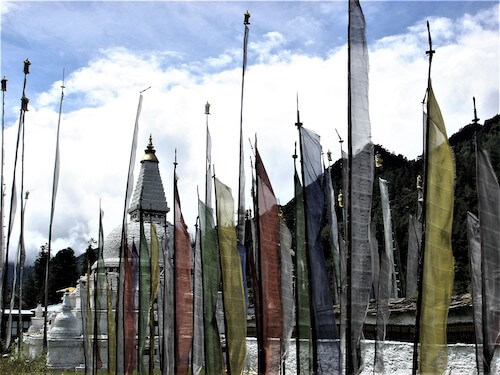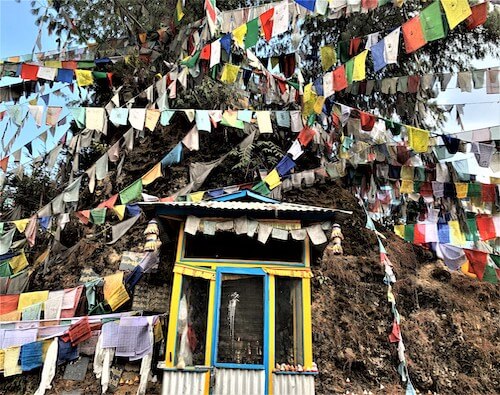 Prayer Flags are ubiquitous in Bhutan, in and around Monasteries, Chortens or Stupas, Dzongs, Lhakhangs, Homes, on the railing of bridges and mountain roads and invariably on or near the summit of the mighty peaks that preside over the country. Red, blue, green, yellow and white, they add a splash of rainbow colours to the rugged landscape.
Prayer Flags are ubiquitous in Bhutan, in and around Monasteries, Chortens or Stupas, Dzongs, Lhakhangs, Homes, on the railing of bridges and mountain roads and invariably on or near the summit of the mighty peaks that preside over the country. Red, blue, green, yellow and white, they add a splash of rainbow colours to the rugged landscape.
Deeply religious, the people of Bhutan believe that with each flutter, a flag releases the prayer printed on it into the air which in turn carries it to the heavens. The more the flag flaps, the greater is its divine value. It is for this reason that prayer flags are positioned that catch the wind – high up on the forested slopes of mountains, across bridges, nearby rivers and streams that tumble down the valleys and anywhere where there is wind and tunnel effect.
The five different colours used in prayer flags represent the five elements of nature: red for fire, blue for water, yellow for earth, white for sky and green for vegetation. Buddhists believe that keeping these five elements in harmony is good for the mind and body.
A typical prayer flag has its central image a horse ('Windhorse or lunga la') bearing three flaming wish-fulfilling jewels on its back. The three jewels represent the Buddha, the Buddhist teachings and the Buddhist community. Around the horse are 20-odd mantras, each dedicated to a particular deity. In addition to the mantras, there are prayers for the long life and good fortune of the person who erects the flag.
The prayers flags seen all over Bhutan are of the following types:
Lung Dhar: Horizontal strings of small, colourful flags commonly hung on a diagonal line from high to low between two objects such as trees or stupas. The centre of a prayer flag traditionally features a 'Lung Dhar' (Wind horse) bearing three flaming jewels on its back. The ‘Dhar’ is a symbol of speed and the transformation of bad to good fortune while the three flaming jewels represent Buddha, Dharma (Buddhist teachings) and the Sangha (Buddhist community).
Each flag also carries special meanings as follows:
Darchog: Vertical prayer flags of rectangular shape and attached to poles along their vertical edge. They are mostly found huddled close together and commonly planted around mountains landscapes and forests.
 Mani: Usually white in colour without any image or diagram on it this 'Dhar' raised after the death of a person. The mantra ‘Om Mani Padme Hum’ related to Chenrezig, the God of Compassion is printed on this prayer flag.
Mani: Usually white in colour without any image or diagram on it this 'Dhar' raised after the death of a person. The mantra ‘Om Mani Padme Hum’ related to Chenrezig, the God of Compassion is printed on this prayer flag.
Vajra Guru Dhar: Usually white in colour and carry the image of Guru Rinpoche and the mantra ‘Om Ah Hum Vajra Guru Pema Siddhi Hum’. There are other general 'Dhars' on which mantras, texts, images of Buddha, Goddess Dema (Tara), Chorten, lion, Dragon etc. are printed.
Gyeltshen Tsemo (Banner of Victory): Symbolises victory with an image of a cylindrical banner printed at the centre. Mantras are also printed around the Gyeltshen Tsemo, including the Tashi Tagye or ‘Eight auspicious signs’ which are used in rituals to proclaim victory over evil.